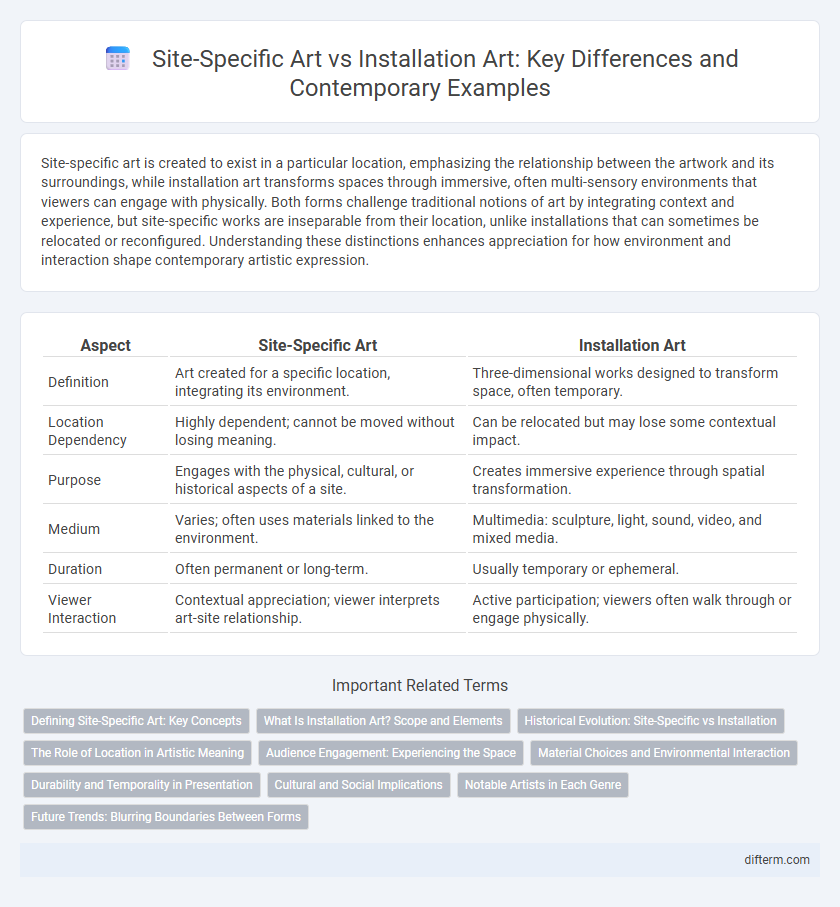Site-specific art is created to exist in a particular location, emphasizing the relationship between the artwork and its surroundings, while installation art transforms spaces through immersive, often multi-sensory environments that viewers can engage with physically. Both forms challenge traditional notions of art by integrating context and experience, but site-specific works are inseparable from their location, unlike installations that can sometimes be relocated or reconfigured. Understanding these distinctions enhances appreciation for how environment and interaction shape contemporary artistic expression.
Table of Comparison
| Aspect | Site-Specific Art | Installation Art |
|---|---|---|
| Definition | Art created for a specific location, integrating its environment. | Three-dimensional works designed to transform space, often temporary. |
| Location Dependency | Highly dependent; cannot be moved without losing meaning. | Can be relocated but may lose some contextual impact. |
| Purpose | Engages with the physical, cultural, or historical aspects of a site. | Creates immersive experience through spatial transformation. |
| Medium | Varies; often uses materials linked to the environment. | Multimedia: sculpture, light, sound, video, and mixed media. |
| Duration | Often permanent or long-term. | Usually temporary or ephemeral. |
| Viewer Interaction | Contextual appreciation; viewer interprets art-site relationship. | Active participation; viewers often walk through or engage physically. |
Defining Site-Specific Art: Key Concepts
Site-specific art is created to exist in a particular location, with its meaning and form intrinsically tied to the physical, cultural, and social context of that site. This art often interacts with architectural elements, landscape features, or historical narratives unique to the location, enhancing viewer engagement through contextual relevance. Unlike installations that can be relocated, site-specific works lose their significance if removed, emphasizing the inseparability of artwork and environment.
What Is Installation Art? Scope and Elements
Installation art is a three-dimensional, site-responsive work designed to transform a viewer's perception of a space. It incorporates diverse elements such as sound, video, sculptural materials, and environmental features to create an immersive experience. Unlike traditional sculptures, installation art emphasizes the interaction between the artwork, the location, and the audience within that environment.
Historical Evolution: Site-Specific vs Installation
Site-specific art emerged in the 1960s as artists began creating works intentionally integrated with a particular location, emphasizing context and environment. Installation art evolved concurrently but expanded to include immersive, multi-sensory experiences that could be relocated or adapted beyond original sites. The historical evolution reflects a shift from rigid, location-dependent art forms to more fluid, interactive expressions that challenge traditional spatial boundaries.
The Role of Location in Artistic Meaning
Site-specific art derives its meaning and impact directly from the physical location where it is created, emphasizing the unique environmental, cultural, and historical context to engage viewers. Installation art, while it may transform a space, often prioritizes the immersive experience and conceptual framework, allowing it to be relocated without losing its core significance. Understanding the role of location reveals how site-specific works are inseparable from place, whereas installations challenge traditional spatial boundaries in contemporary art practices.
Audience Engagement: Experiencing the Space
Site-specific art transforms environments by responding directly to the physical, historical, or cultural context, fostering a deep connection between the audience and location. Installation art creates immersive experiences by engaging viewers through multi-sensory elements and spatial dynamics, often encouraging interaction within the constructed environment. Both forms prioritize audience engagement by shaping how visitors experience and interpret the space, enhancing emotional and cognitive responses to the artwork.
Material Choices and Environmental Interaction
Site-specific art integrates local materials and environmental conditions to create a unique dialogue between artwork and its location, emphasizing natural elements like stone, wood, or earth. Installation art employs diverse, often synthetic materials to construct immersive environments that transform space and viewer perception without necessarily engaging with local ecological features. Material choices in site-specific work prioritize sustainability and blending with surroundings, whereas installations focus on sensory impact and conceptual framing through varied mediums.
Durability and Temporality in Presentation
Site-specific art is designed to exist permanently within a unique location, emphasizing durability and integration with the environment to enhance its meaning. Installation art often embraces temporality, utilizing transient materials and ephemeral setups that highlight the fleeting experience and transformation over time. Durability in site-specific works contrasts with the intentional impermanence in installations, shaping their presentation and audience interaction.
Cultural and Social Implications
Site-specific art deeply engages with its environment, reflecting and often challenging local cultural narratives and social dynamics, thereby fostering a unique dialogue between the artwork and its community. In contrast, installation art, while immersive, tends to prioritize spatial experience and sensory impact, sometimes abstracting or universalizing cultural themes rather than embedding itself in a particular social context. Both forms influence cultural identity and social interaction differently, with site-specific works often provoking direct community engagement and installation art offering broader, multisensory interpretations of social issues.
Notable Artists in Each Genre
Site-specific art features works designed uniquely for a particular location, with notable artists including Richard Serra, known for his massive steel sculptures that interact with architectural and natural environments. Installation art, often immersive and multi-sensory, boasts distinguished artists like Yayoi Kusama, whose Infinity Mirror Rooms create captivating, enveloping experiences. Both genres emphasize spatial interaction but differ in permanence and context, reflecting distinct artistic approaches to environment and viewer engagement.
Future Trends: Blurring Boundaries Between Forms
Site-specific art and installation art increasingly converge as future trends push the boundaries between these forms, emphasizing immersive experiences tailored to unique environments. Emerging technologies like augmented reality and interactive media amplify this integration, allowing artists to create dynamic works that respond to both physical space and audience interaction. The dissolution of traditional distinctions fosters innovative expressions that redefine spatial engagement and cultural narratives.
Site-specific vs Installation Infographic

 difterm.com
difterm.com